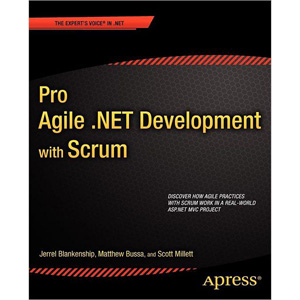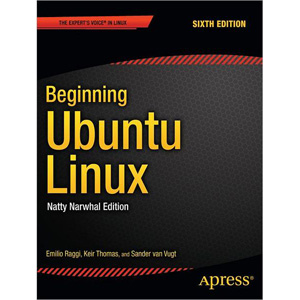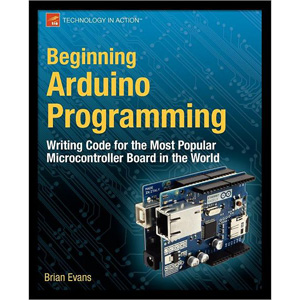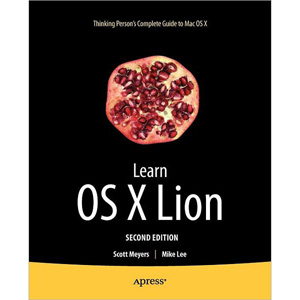5 new posts |  |
- Pro Agile .NET Development with SCRUM
- Beginning Ubuntu Linux: Natty Narwhal Edition, 6th Edition
- Beginning Arduino Programming
- Learn OS X Lion, 2nd Edition
- Preventing Good People From Doing Bad Things
| Pro Agile .NET Development with SCRUM Posted: 24 Oct 2011 08:06 AM PDT
Book DescriptionPro Agile .NET Development with SCRUM guides you through a real-world ASP.NET project and shows how agile methodology is put into practice. There is plenty of literature on the theory behind agile methodologies, but no book on the market takes the concepts of agile practices and applies these in a practical manner to an end-to-end ASP.NET project, especially the estimating, requirements and management aspects of a project. Pro Agile .NET Development with SCRUM takes you through the initial stages of a project–gathering requirements and setting up an environment–through to the development and deployment stages using an agile iterative approach: namely, Scrum. In the book, you’ll focus on delivering an enterprise-level ASP.NET project. Each chapter is in iterations or sprints, putting into practice the features of agile–user stories, test-driven development (TDD), behavior-driven development (BDD), continuous integration, user acceptance testing, extreme programming, Scrum, design patterns and principles, inside-out development, lean developent, KanBan boards, and more. An appendix features code katas designed for the reader to get up-to-speed with some of the features of extreme programming, while also showcasing popular open-source frameworks to assist in automated testing and mocking. What you’ll learn
Who this book is for Table of Contents
Book Details
Related Posts
|
| Beginning Ubuntu Linux: Natty Narwhal Edition, 6th Edition Posted: 24 Oct 2011 08:06 AM PDT
Book DescriptionThis sixth edition of Beginning Ubuntu Linux introduces all of us—newbies, power users and system administrators—to the Natty Narwhal Ubuntu release. Based on the bestselling fifth edition, this edition introduces the new Unity interface while not neglecting the finely-tuned administration techniques for new users present in previous editions. Whether you aim to use it in the home or in the office, you'll be introduced to the complete world of Ubuntu Linux, from simple word processing to using cloud services. You'll learn how to control the Ubuntu system which you just installed as you are guided through common tasks, such as configuring the system’s graphical user interface, listening to audio CDs and MP3s, producing documents, using VoIP and chat, and of course, general system maintenance. Emilio also introduces the improved software center and Ubuntu’s multitouch capabilities. This book supplies a series of comprehensive tutorials on Ubuntu administration and security—essential for any Ubuntu user—while not neglecting matters pertaining to office applications and the Cloud. What you'll learn
Who this book is for Table of Contents
Book Details
Related Posts
|
| Posted: 24 Oct 2011 04:41 AM PDT
Book DescriptionBeginning Arduino Programming provides a clear introduction to writing Arduino code, building your skills with Arduino through a series of well-designed hardware and software building blocks. Once you have read this book, you’ll be ready to program Arduino in exactly the ways you want for your future projects. Beginning Arduino Programming lets you discover new journeys with your Arduino board through programming. While everyone knows that Arduino is a platform for hardware hackers—be they engineers, artist or maker-enthusiasts—your Arduino board cannot function without code. This book will show you the fundamentals of programming and how to program your Arduino board to do the things you want it to do. You’ll learn from first principles the core Arduino programming language, examining how to program loops, variables, arrays, and functions. While these features are common to many languages, you’ll also learn how they are used specifically for Arduino. Beginning Arduino Programming uses the sketching analogy, which means you’ll find yourself writing snippets of code that do interesting things very quickly. You’ll also learn how to code in a good, succinct Arduino style that other programmers will respect. As you read Beginning Arduino Programming, you’ll learn how to make your Arduino code talk directly to the chips and sensors on your boards, taking into account pulse width, timing and sensor characteristics, all under your control. You’ll then be ready to discover the joys of the existing Arduino open source libraries, so you can benefit from the code that other people have already created, and even think about sharing your own Arduino code projects in the future. What you'll learn
Who this book is for Table of Contents
Book Details
Related Posts
|
| Posted: 24 Oct 2011 04:41 AM PDT
Book DescriptionYou're smart and savvy, but you’re also busy. This comprehensive guide to Apple’s latest version of OS X, Lion, gives you everything you need to know to live a happy, productive Mac life. Learn OS X Lion will have you up and connected right away. With a minimum of overhead and a maximum of useful information, you'll cover a lot of ground in the time it takes other books to get you plugged in. If this isn't your first experience with OS X, skip right to the “What's New in Lion” sections. You may also find yourself using this book as a quick refresher course or a way to learn new Mac skills you've never tried before. What you'll learn
Who this book is for Table of Contents
Book Details
Related Posts
|
| Preventing Good People From Doing Bad Things Posted: 24 Oct 2011 04:41 AM PDT
Book DescriptionIn today's turbulent technological environment, it's becoming increasingly crucial for companies to know about the principle of least privilege. These organizations often have the best security software money can buy, with equally developed policies with which to execute them, but they fail to take into account the weakest link in their implementation: human nature. Despite all other efforts, people can sway from what they should be doing. Preventing Good People from doing Bad Things drives that concept home to business executives, auditors, and IT professionals alike. Instead of going through the step-by-step process of implementation, the book points out the implications of allowing users to run with unlimited administrator rights, discusses the technology and supplementation of Microsoft's Group Policy, and dives into the different environments least privilege affects, such as Unix and Linux servers, and databases. Readers will learn ways to protect virtual environments, how to secure multi-tenancy for the cloud, information about least privilege for applications, and how compliance enters the picture. The book also discusses the cost advantages of preventing good people from doing bad things. Each of the chapters emphasizes the need auditors, business executives, and IT professionals all have for least privilege, and discuss in detail the tensions and solutions it takes to implement this principle. Each chapter includes data from technology analysts including Forrester, Gartner, IDC, and Burton, along with analyst and industry expert quotations. What you'll learn
Who this book is for Table of Contents
Book Details
|
| You are subscribed to email updates from Wow! eBook - Blog To stop receiving these emails, you may unsubscribe now. | Email delivery powered by Google |
| Google Inc., 20 West Kinzie, Chicago IL USA 60610 | |






Tidak ada komentar:
Posting Komentar